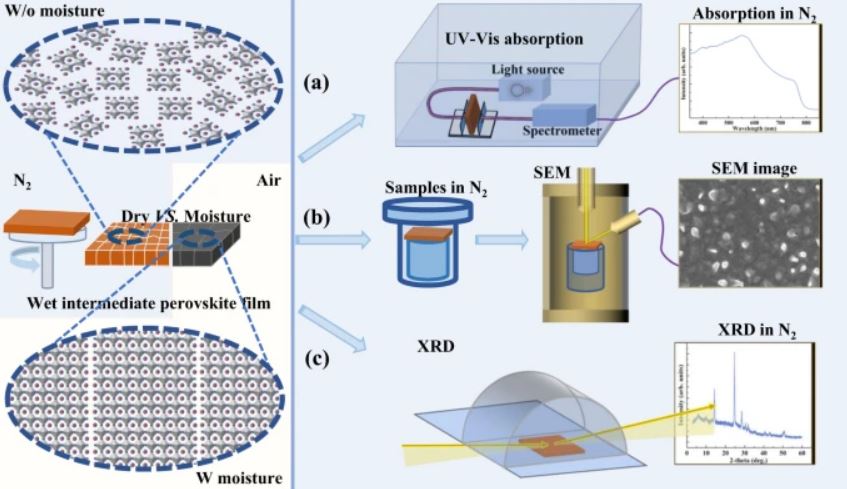A group of scientists from the Huaqiao University in China has investigated the effects of moisture in the air on the intermediate and final perovskite films in solar cells and has proposed to use a controllable moisture treatment consisting of a series of nitrogen (N2)-protected characterization techniques.
“Many previous reports claimed that moisture could penetrate the bulk of perovskite film, destroy the organic-inorganic interactions, and generate the undesired lead(II) iodide (PbI2), resulting in the loss of photovoltaic properties,” they explained. “The disruptive effect of H2O on perovskite was ascribed to the irreversible hydration process, leading to the degradation of perovskite to (PbI2.). However, when the dose of H2O was low, this hydration process was reversible, and the hydrated product could spontaneously dehydrate in a dry atmosphere.”
The researchers analyzed the effects of moisture by protecting and characterizing the metastable perovskite samples with various N2-filled cabins. They investigated, in particular, the evolution of wet perovskite films before and after moisture treatment by UV-vis spectroscopy (UV-vis), steady-state photoluminescence (PL), X-ray photoelectron spectroscopy (XPS), X-ray diffraction (XRD), scanning electron microscopy (SEM), nuclear magnetic resonance (NMR), and thermogravimetric analysis (TGA).
“We found that the humidified film can trigger the quasi-solid-solid reaction between organic salts and PbI2, realizing a rapid homogeneous distribution of the PbI2-organic salts complex,” they stated. “Consequently, the resultant perovskite films exhibited a more homogenous perovskite phase with larger crystal grains and higher crystallinity.”
Popular content
They fabricated a 0.2 cm2 solar cell with perovskite films fabricated through a sequential two-step deposition process and obtained the PbI2 films by spin-coating the PbI2 solution onto substrates made of indium-tin-oxide and tin oxide (ITO/SnO2). The cell was based on a Spiro-OMeTAD precursor. Its efficiency and stability were tested under 100 mW cm−2 illumination. “Finally, we obtained a power conversion efficiency of approaching 24% (23.93%) with improved open-circuit voltage and fill factor,” they highlighted. “Moreover, the corresponding device can remain over 80% of initial efficiency after continuous 1-sun illumination of over 1200 h, showing robust operational stability.”
They described the device in the paper “Moisture-triggered fast crystallization enables efficient and stable perovskite solar cells,” which was recently published in nature communications. “This work gives a feasible method for investigating metastable substances under protective conditions,” they concluded.
This content is protected by copyright and may not be reused. If you want to cooperate with us and would like to reuse some of our content, please contact: editors@pv-magazine.com.



1 comment
By submitting this form you agree to pv magazine using your data for the purposes of publishing your comment.
Your personal data will only be disclosed or otherwise transmitted to third parties for the purposes of spam filtering or if this is necessary for technical maintenance of the website. Any other transfer to third parties will not take place unless this is justified on the basis of applicable data protection regulations or if pv magazine is legally obliged to do so.
You may revoke this consent at any time with effect for the future, in which case your personal data will be deleted immediately. Otherwise, your data will be deleted if pv magazine has processed your request or the purpose of data storage is fulfilled.
Further information on data privacy can be found in our Data Protection Policy.